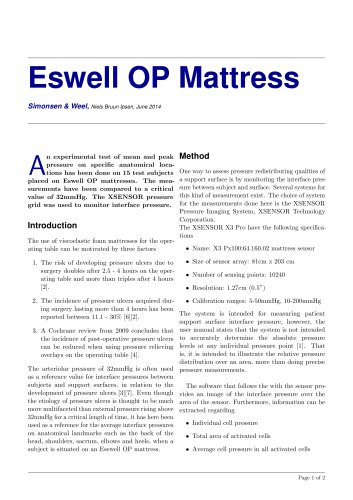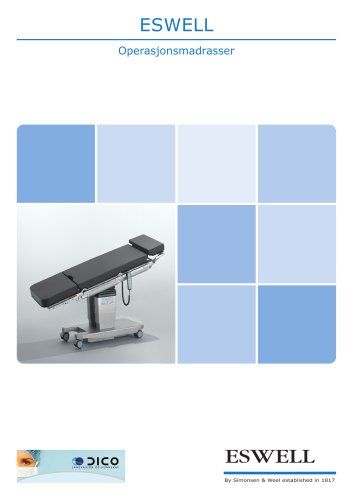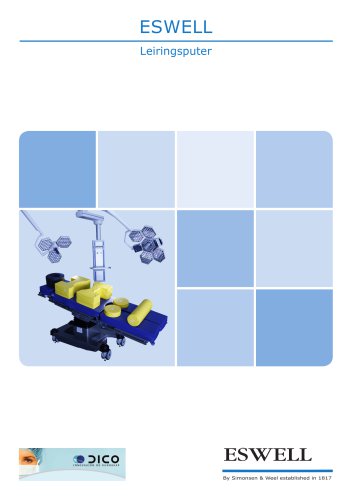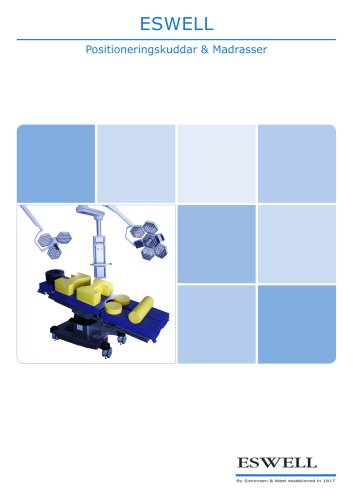
Catalog excerpts
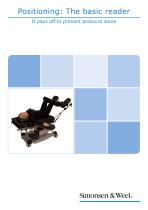
Positioning: The basic reader It pays off to prevent pressure sores
Open the catalog to page 1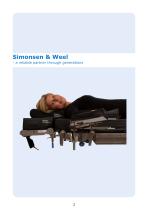
Simonsen & Weel - a reliable partner through generations
Open the catalog to page 2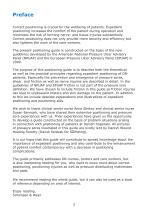
Preface Correct positioning is crucial for the wellbeing of patients. Expedient positioning increases the comfort of the patient during operation and minimizes the risk of forming nerve- and tissue injuries substantially. Correct positioning does not only provide more security and efficiency but also lightens the work of the care workers. The present positioning guide is constructed on the basis of the new guidelines developed by the American National Pressure Ulcer Advisory Panel (NPUAP) and the European Pressure Ulcer Advisory Panel (EPUAP) in 2009. The purpose of this positioning guide...
Open the catalog to page 3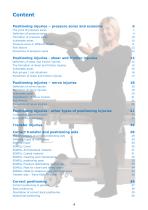
Content Positioning injuries – pressure sores and economy The price of pressure sores Definition of pressure sores Formation of pressure sores Vulnerable areas Pressure sores in different stages Risk factors Prevention of pressure sores Positioning injuries - shear and friction injuries Positioning injuries – nerve injuries Positioning injuries - other types of positioning injuries Transfer injuries Correct transfer and positioning aids Correct positioning Definition of shear and friction injuries The formation of shear and friction injuries Vulnerable areas Risk groups / risk situations...
Open the catalog to page 4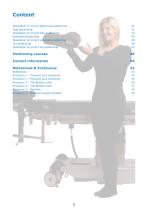
Content Illustration of correct abdominal positioning 41 Side positioning 42 Illustration of correct side positioning 43 Extension positioning 44 Illustration of correct extension positioning 45 GU-positioning 46 Illustration of correct GU-positioning 47 Positioning courses Contact information References & Enclosures References Enclosure 1 Enclosure 1 Enclosure 2 Enclosure 2 Enclosure 3 Enclosure 4 – Pressure sore screening – Pressure sore screening – The Braden scale – The Braden scale - Nutrition - Pressure Imaging System
Open the catalog to page 5
Positioning injuries – pressure sores and economy
Open the catalog to page 6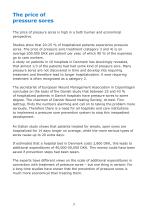
The price of pressure sores The price of pressure sores is high in a both human and economical perspective. Studies show that 20-25 % of hospitalized patients experience pressure sores. The price of pressure sore treatment (category 3 and 4) is on average 200.000 DKK per patient per year, of which 90 % of the expenses go to care workers. A study on patients in 10 hospitals in Denmark has shockingly revealed, that almost 1/3 of the patients had had some kind of pressure sore. Many pressure sores are not discovered in time and develop into requiring treatment and therefore lead to longer...
Open the catalog to page 7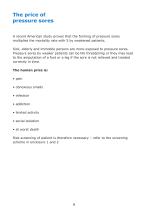
The price of pressure sores A recent American study proves that the forming of pressure sores multiplies the mortality rate with 5 by weakened patients. Sick, elderly and immobile persons are more exposed to pressure sores. Pressure sores by weaker patients can be life threatening or they may lead to the amputation of a foot or a leg if the sore is not relieved and treated correctly in time. The human price is: • pain • obnoxious smells • infection • addiction • limited activity • social isolation • at worst death Risk screening of patient is therefore necessary – refer to the screening...
Open the catalog to page 8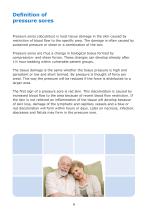
Definition of pressure sores Pressure sores (decubitus) is local tissue damage in the skin caused by restriction of blood flow to the specific area. The damage is often caused by sustained pressure or shear or a combination of the two. Pressure sores are thus a change in biological tissue formed by compression- and shear forces. These changes can develop already after 1½ hour bedding within vulnerable patient groups. The tissue damage is the same whether the tissue pressure is high and persistent or low and short termed. By pressure is thought of force per areal. This way the pressure will...
Open the catalog to page 9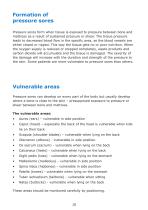
Formation of pressure sores Pressure sores form when tissue is exposed to pressure between bone and mattress as a result of sustained pressure or shear. The tissue pressure leads to decreased blood flow in the specific area, as the blood vessels are either closed or ripped. This way the tissue gets no or poor nutrition. When the oxygen supply is reduced or stopped completely, waste products and carbon dioxide will accumulate and the tissue is damaged. The severity of the damage will increase with the duration and strength of the pressure to the skin. Some patients are more vulnerable to...
Open the catalog to page 10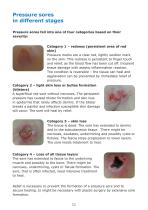
Pressure sores in different stages Pressure sores fall into one of four categories based on their severity: Category 1 – redness (persistent area of red skin) Pressure marks are a clear red, lightly swollen mark on the skin. This redness is persistent to finger touch and relief, as the blood flow has been cut off. Incipient tissue damage with aseptic inflammation reaction. The condition is reversible – the tissue can heal and aggravation can be prevented by immediate relief of pressure. Category 2 – light skin loss or bullae formation (blisters) A superficial red sore without necroses. The...
Open the catalog to page 11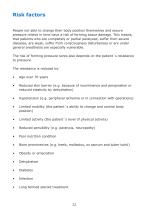
Risk factors People not able to change their body position themselves and secure pressure relieve in time have a risk of forming tissue damage. This means, that patients who are completely or partial paralyzed, suffer from severe diseases, are weak, suffer from consciousness disturbances or are under general anesthesia are especially vulnerable. The risk of forming pressure sores also depends on the patient´s resistance to pressure. The resistance is reduced by: • Reduced skin barrier (e.g. because of incontinence and perspiration or reduced elasticity by dehydration) Hypotension (e.g....
Open the catalog to page 12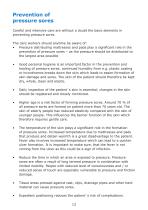
Prevention of pressure sores Careful and intensive care are without a doubt the basic elements in preventing pressure sores. The care workers should anytime be aware of: • Pressure distributing mattresses and pads play a significant role in the prevention of pressure sores – as the pressure should be distributed to the largest area possible • Good personal hygiene is an important factor in the prevention and healing of pressure sores; continued humidity from e.g. plastic coating or incontinence breaks down the skin which leads to easier formation of skin damage and sores. The skin of the...
Open the catalog to page 13All Eswell catalogs and technical brochures
-
Test of positioning pads
6 Pages
-
ESWELL Leiringsputer Norwegian
16 Pages
-
Lejringsbog Danish
60 Pages


